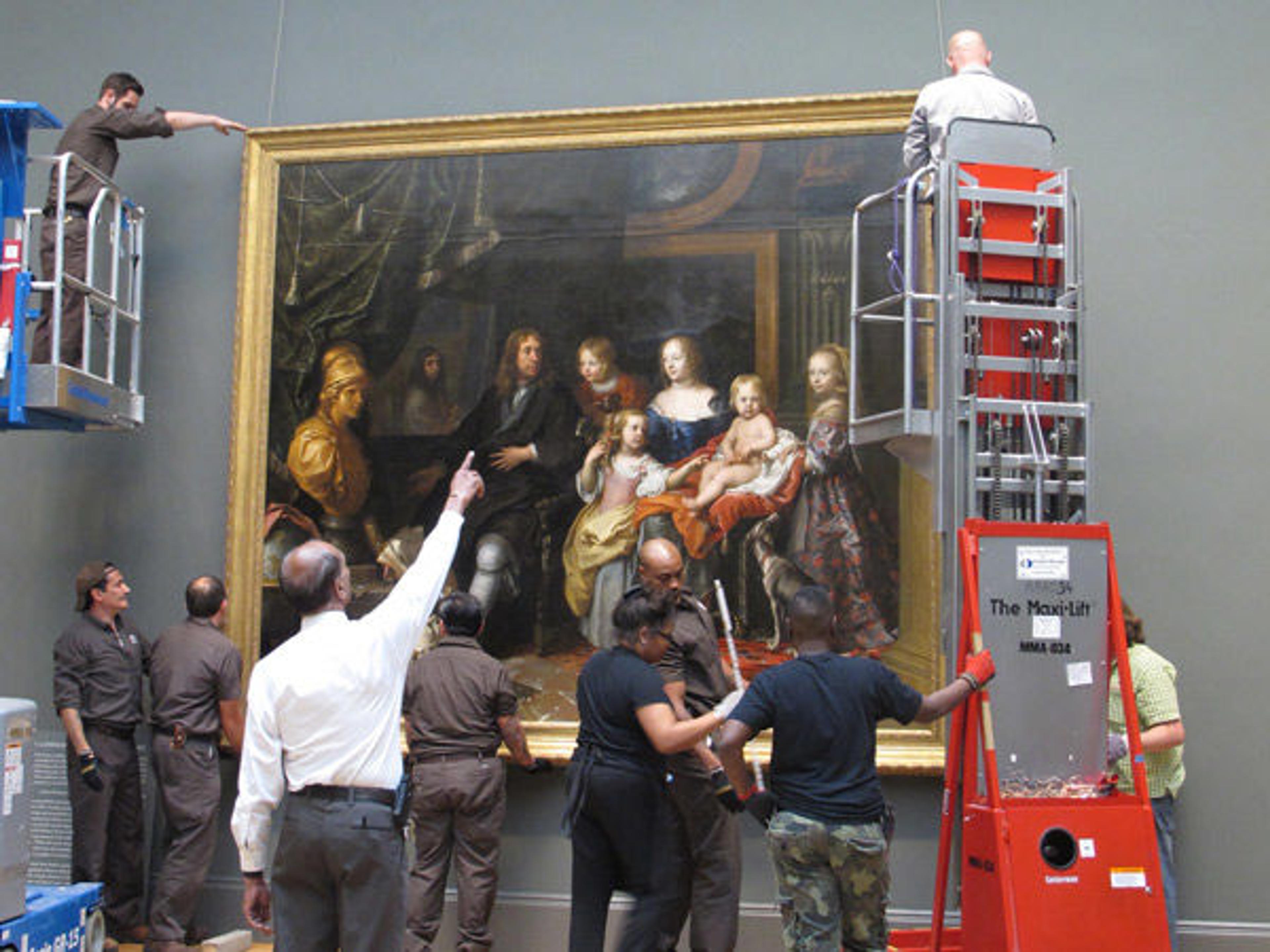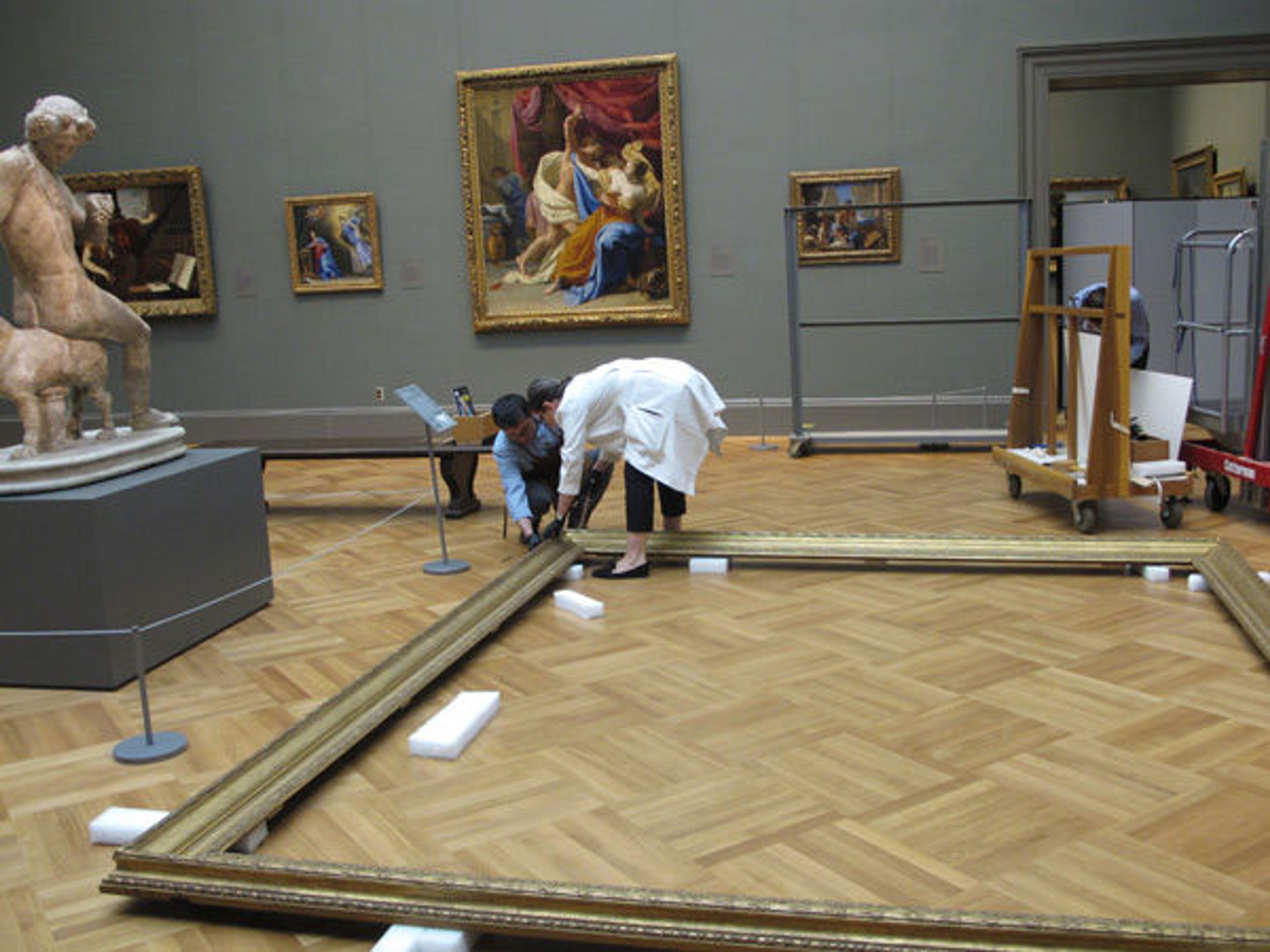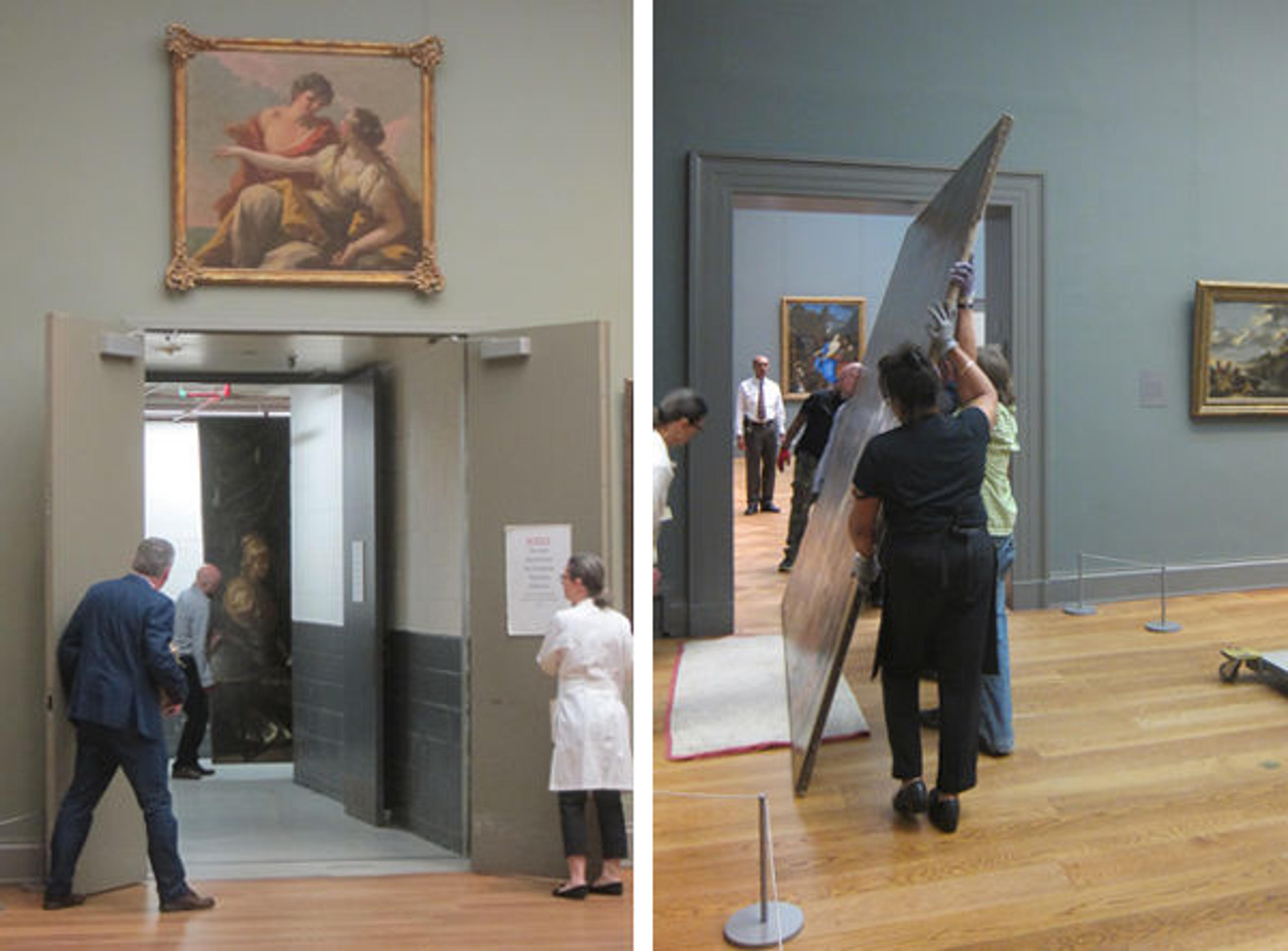The Jabachs Are in the House!

The Museum's riggers hanging the 350-pound Jabach portrait in gallery 617 yesterday afternoon
«At long last, after ten months of conservation work, Charles Le Brun's arresting portrait of Everhard Jabach and his family is now on view in the galleries.»
Last week, Michael Gallagher applied the final varnish to the painting, and it is wonderful to see how the picture has come together. Now that the surface is fully saturated, I am even more mesmerized by the sumptuousness of the textiles, the tactility of the objects, and the liveliness of the various figures; it's no easy task to convey the tender flesh of a baby, the luminous complexion of youth, and the weathered features of a middle-aged man in such close proximity. The handling of the composition and the masterful execution of the painting give us an entirely new sense of the depth and range of Le Brun's talents with the brush.
Once the conservation was complete, the painting was photographed, and the original image of the painting on our website was replaced with a new one. The work looks fantastic online, where visitors can zoom in and out of the painting, or study it alongside the other posted images.

Following conservation, the painting was photographed in the Paintings Conservation studio.
It was then time to see the painting in its new frame. As you may remember, because the canvas is now restored to its original dimensions, we commissioned a Parisian framer to craft an appropriate frame. The assembled frame would have been too large to ship across the Atlantic, so it arrived on our loading dock in four pieces. This ended up being fortunate. As it turns out, although the painting can just squeeze through the Museum's various doors and passageways, the frame would have been too large to pass through the door of the gallery itself. Before even getting to that, though, the conservators needed to test out the frame's dimension in the studio. The dry run couldn't have gone better: the conservators were relieved not only that the measurements were right, but that the finished frame worked so well with the painting. Keith Christiansen and I were in Paris when all this happened, so we were afforded the special pleasure of seeing the framed picture for the first time in the gallery.

The new frame created for the Jabach portrait, shown in pieces before assembly
Getting the painting into the gallery yesterday went off without a hitch. The day began with taking the elements of the frame into the gallery to begin assembly. The impressive size of the painting that we were about to install quickly became apparent.

Conservators Alan Miller and Cynthia Moyer assembling the frame in the gallery
This became especially clear when the painting arrived on the second floor for the first time. There was total silence, followed by a collective sigh of relief when the painting passed through the door into the gallery.

Moving the painting through a corridor and into the gallery
Finally, it took all hands, from several departments, to hang the 350-pound painting.
Since arriving at the Museum a couple of months ago, I have thought a lot about how we would present the picture. Anyone following our blog posts about the work can well imagine how many possibilities there were. Would it be illuminating to see the painting in the company of objects like the ones it depicts? Would it be interesting to assess it with other family portraits? Or perhaps with paintings that deal with mirrors and reflections? The possibilities seemed endless. In the end, what has struck me most is that this remarkable work, an undisputed landmark in the history of Western painting, has been given to the Museum to become part of its permanent collection. The most fitting way to introduce the painting, ultimately, was to present it in the gallery devoted to seventeenth-century French painting and allow viewers to assess it on its own terms.

The newly conserved Jabach portrait hanging in gallery 617 between portraits by Le Brun's contemporaries Philippe de Champaigne and Simon Vouet
That said, we are fortunate to have two portraits that work especially well on either side of the Jabachs. The first, by Philippe de Champaigne, is of Jean-Baptiste Colbert, who was principal advisor to Louis XIV's mother during his minority and was later appointed the king's minister of finance. He and Le Brun took charge of the Royal Academy in 1648, and in 1666 founded the French Academy in Rome. The two formed a formidable alliance: Colbert was instrumental in reforming the arts to serve the monarchy.
The second painting is a portrait by Simon Vouet, under whom Le Brun worked early in his career. Although Vouet is better known as a painter of religious and allegorical subjects, he made portraits throughout his life. Some of these (in pastel) are of Louis XIII, who asked the artist to teach him how to draw—see the Museum's recently acquired drawing of Louis XIII by Vouet. The portrait on view here, from a private collection, was executed when Vouet was a young artist in Rome and captures the essence of its subject in a fleeting moment. Le Brun had a fraught relationship with his former teacher and was conspicuously excluded from membership in the Royal Academy when it was founded.
It is also wonderful to see the Jabachs in proximity to Le Brun's earlier painting, The Sacrifice of Polyxena, which the Museum acquired in 2013. There is now no other museum outside of France where the artist can be studied and considered so well.
It is hard to imagine that Le Brun's grand portrait of the Jabach family hasn't been seen by an art-seeking public since the eighteenth century. You may recall from an earlier post that the painting was then a principal attraction in Cologne, garnering admiration from the likes of Goethe and Sir Joshua Reynolds (who saw the Berlin version). Too bad that Henry Hope, who later took the painting to the Netherlands, hadn't yet acquired it when Thomas Jefferson visited him in 1788. Alas, Jefferson missed it; don't you!
Stephan Wolohojian
Stephan Wolohojian is a curator in the Department of European Paintings.